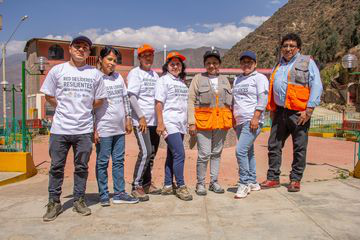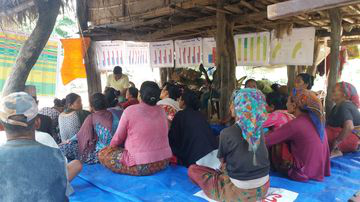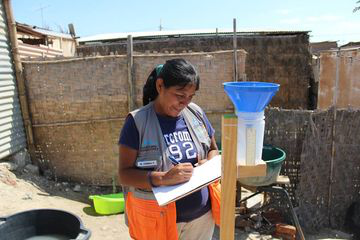In recognition of this year’s International Day for Disaster Risk Reduction focusing on the importance of governance this blog reflects on how despite broad agreement as to the benefits of Community Based Disaster Risk Reduction, communities at risk remain largely excluded from disaster risk reduction governance.
Local communities still left behind in disaster risk reduction
Hundreds of millions of people are affected by disasters every year. People who, according to Global Network of Civil Society Organisations for Disaster Reduction (GNDR) research, are usually left without a voice when risk management decisions are made. Only 16% of people most at risk of natural hazards reported feeling included in decision-making on how reduce their own risks.
Good and effective Disaster Risk Reduction (DRR) governance requires an all-society approach where those at risk are put at the heart of DRR. This simple idea is at the very core of community-based disaster risk reduction.
The basics of community-based disaster risk reduction
In community-based disaster risk reduction (CBDRR), communities at risk identify and prioritise their problems, and are empowered to come up with, implement, and sustain solutions that work for them and their contexts. The rationale is simple: people experiencing natural hazards know best how and why they are affected, are experts at finding appropriate and sustainable solutions, and have the most to gain from successful risk reduction activities.

A mismatch between policy, theory, and practice?
While the idea of CBDRR seems revolutionary, the reality of implementation on the ground often has little to do with the ideas shaping the approach.
In my PhD, I critically explored the reality of community-based flood risk management in the Lower Shire Valley in Malawi, where CBDRR is the predominant approach for dealing with flood risk. I found that CBDRR only marginally improves the situation on the ground, while long-lasting and transformative solutions remain under-delivered. Some of the core governance-related challenges I found during my research were:
- Participation is inadequate: Local communities are largely overlooked and only marginally involved in project design. They have limited power to influence the process and virtually have no say in policy making. Lack of understanding and consideration for complex power relationships within a community means those poorest and most marginalised often don’t get a say even when a community is consulted.
- Funding is not appropriate for the scale of the problem: The government has no dedicated resources for CBDRR. What resources exist are focused towards disaster response. There is a high reliance on NGOs and donor funding both in DRR and emergency response.
- Multi-stakeholder effort is complex: Some of the core components of ‘good’ governance are missing: there is a lack of coordination between different stakeholders, and accountability, especially towards local communities, is limited.
- CBDRR does not make it into local government plans and strategies: Although communities make detailed plans as part of CBDRR, these are rarely consolidated and considered in district-level planning.
As a result, CBDRR in Malawi is characterised by a complete lack of sustainability. Similar challenges exist in different geographical contexts too. Despite the benefits of community inclusion in DRR and a strong policy push, the mismatch between theory, policy, and realities on the ground persists.
What are we doing to overcome challenges of community-based approaches?
In Practical Action, we are taking these challenges seriously.
Community participation drives all of our activities. All our work within the Zurich Flood Resilience Alliance is grounded in the Flood Resilience Measurement for Communities (FRMC), a framework and tool that in close collaboration with the community allows understanding of existing sources of flood resilience and how these can be enhanced.

We understand that participation goes beyond community consultation, and requires understanding of the diversity of experience and vulnerability within a community. Our team has developed an innovative Missing Voices methodology, capturing perspectives of marginalised women including among others those who are elderly, are living with disabilities, single mothers, and transgender women.
Inclusion of communities in DRR governance is only possible if bridges are built between communities and local governments. In Peru, we have helped establish links between community volunteers and the Peruvian National Service of Meteorology and Hydrology, where volunteers collect local-level rainfall data and share this with national government to improve understanding of rainfall and associated risks. As a result the Government has implemented a national policy promoting the collection of daily weather data by voluntary groups across the country. We have also been one of few civil society organisations providing inputs into the National Plan of Action on Gender and Climate Change in Peru.

Based on the analysis conducted through FRMC in Nepal, we worked through local administrative structures to inform annual Local Disaster and Climate Resilience Plans. As a result, we have seen the governments of Rajapur, Tikapur, and Geruwa allocate funds to improve response capacities within local government and communities, improve access to early warning systems and climate information, and increase livelihood options and livelihood security.
As local voices get lost in international arenas organisations like Practical Action can play a role in making sure experiences on the ground are heard and considered. Through our work with Climate Action Network and BOND, we are continuously advocating for increased climate finance for the poorest and most vulnerable and acknowledgment of Loss and Damage as a crucial pillar of climate action.
Where next?
We can only build disaster resilient futures if communities at risk are recognised as leaders in the governance of disaster risks. We already have tools and approaches to do so, but the gaps between policies, theory, and practice remain large. Local-level action, based on meaningful participation of communities at risk, should go beyond one-off projects. It has to be central to DRR planning at local government level, provide a blueprint for national plans, and be properly resourced – the international policy and funding landscape is instrumental in facilitating systemic change at local and national levels.

Comments